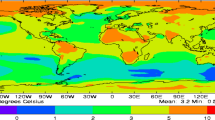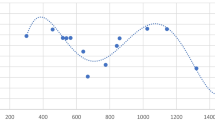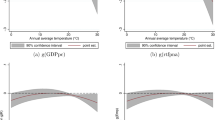Abstract
British pre-industrial economic growth has traditionally been analysed from the Malthusian point of view and other more optimistic approaches, but in many cases, ignoring environmental factors. This article explores the inclusion of the climate in this general debate, focusing on one of the colder periods of the last 500 years, known as the Maunder Minimum. The provisional results suggest that climate change and the resulting adaptations may have influenced the start of the English Agricultural Revolution, the Energy Transition and the European Divergence. However, from an econometric point of view these results are not fully conclusive, making it necessary to continue working with better primary sources and other alternative methodologies.


Similar content being viewed by others
References
Alfani G, Murphy TE (2017) Plague and lethal epidemics in the pre-industrial world. J Econ Hist 77(1)
Allen RC (2009) The British industrial revolution in global perspective. Cambridge University Press, Cambridge
Allen RC, Weisdorf JL (2011) Was there an ‘industrious revolution’ before the industrial revolution? An empirical exercise for England, c. 1300–1830. Econ Hist Rev 64(3):715–729
Almond D, Currie J (2011) Killing me softly: the fetal origins hypothesis. J Econ Perspect 25:153–172
Appleby AB (1979) Grain prices and subsistence crises in England and France, 1590-1740. J Econ Hist 39(4):865–887
Appleby AB (1980) Epidemics and famine in the little ice age. J Interdiscip Hist 10(4):643–663
Beier A, Finlay R (eds) (1986) London 1500–1700: the making of the Metropolis. Longman, New York
Bhattacharya J, Deleire T, Haider S, Currie J (2003) Heat or eat? Cold-weather shocks and nutrition in poor American families. Am J Public Health 93(7)
Braga AL, Zanobetti A, Schwartz J (2001) The time course of weather-related deaths. Epidemiology 12(6):662–667
Braga AL, Zanobetti A, Schwartz J (2002) The effect of weather on respiratory and cardiovascular deaths in 12 U.S. cities. Environ Health Perspect 110(9):859–863
Brázdil R, Drobrovolný LJ, Moberg A, Pfister CH, Wheeler D, Zurita E (2010) European climate of the past 500 years: new challenges for historical climatology. Clim Chang 101:7–40
Broadberry S, Campbell B, Klein A, Overton M, van Leeuwen B (2015) British economic growth, 1270–1870. Cambridge University Press
Brunt L (2004) Nature or nurture? Explaining English wheat yields in the industrial revolution, c.1770. J Econ Hist 64(1):193–225
Brunt L (2015) Weather shocks and english wheat yields, 1690-1871. Explor Econ Hist 57:50–58. https://doi.org/10.1016/j.eeh.2014.12.001
Camenisch C, Rohr C (2018) When the weather turned bad. The research of climate impacts on society and economy during the little ice age in Europe. An overview. Cuadernos de Investig Geogr 44(1):99–114. Universidad de La Rioja. https://doi.org/10.18172/cig.3395
Camenisch et al (2016) The 1430s: a cold period of extraordinary internal climate variability during the early Spörer minimum with social and economic impacts in north-western and Central Europe. Clim Past 12:2107–2126 www.clim-past.net/12/2107/2016/doi:10.5194/cp-12-2107-2016
Campbell BMS (2010) Nature as historical protagonist: environment and society in pre-industrial England. Econ Hist Rev 63(2):281–314
Campbell BMS (2016) The great transition: climate, disease and Society in the Late-Medieval World. Cambridge University Press
Claessens van Ooijen AM, Westerterp KR, Wouters L, Schoffelen PF, Steenhoven AA, Lichtenbelt WD (2006) Heat production and body temperature during cooling and rewarming in overweight and lean men. Obesity 14:1914–1920. https://doi.org/10.1038/oby.2006.223
Clark G (2004) The Price history of English agriculture, 1209-1914. Res Econ Hist 22:41–124
Clark G (2005) The condition of the working-class in England, 1209-2004. J Polit Econ 6(113):1307–1340
Clark G (2007) The long march of history: farm wages, population and economic growth, England 1209-1869. Econ Hist Rev 60(1):97–135
Coleman DC (1956) Labour in the English economy of the seventeenth century. Econ Hist Rev 3(8):280–295
Collins, M.; Osborn, T. J.; Tett, S.F. B.; Briffa, K. R.; F. H. Schweingruber (2002): A comparison of the variability of a climate model with paleotemperature estimates from a network of tree-ring densities, J Clim, vol 15, n° 13, pp. 1497–1515
Cooper RJ, Melvin I, Tyers RJS, Wilson K, Briffa (2012) A tree-ring reconstruction of east Anglian (UK) hydroclimate variability over the last millennium. Clim Dyn
Crafts N, Mills TC (2017) Six centuries of British economic growth: a time-series perspective. Eur Rev Econ Hist 21:141–158
Cullen K (2010) Famine in Scotland-the ‘Ill Years' of the 1690s, vol 16. Edinburgh University Press
de Vries J (1984) (1984) European urbanization: 1500–1800. Methuen, London
de Vries J (1994) The industrial revolution and the industrious revolution. J Econ Hist 54:249–270
Dell M, Jones BF, Olken BA (2012) Temperature shocks and economic growth: evidence from the last half century. Am Econ J Macroecon 4(3):66–95
Dell M, Jones BJ, Olken BA (2014) What do we learn from the weather? The new climate–economy literature. J Econ Lit 52(3):740–798. https://doi.org/10.1257/jel.52.3.740
Deschênes O, Greenstone M (2012) The economic impacts of climate change: evidence from agricultural output and random fluctuations in weather: reply. Am Econ Rev 102(7):3761–3773
Eddy J (1976) The Maunder Minimum. Science 192(4245):1189–1202
Feola G, Lerner A, Jain M, Montefrio M, Nicholas K (2014) Farmer responses to multiple stresses in the face of global change: assessing five case studies to enhance adaptation. http://ifsa.boku.ac.at/cms/fileadmin/Proceeding2014/WS_3_3_Feola.pdf
Finzi R (1986) Il sole, la pioggia, il pane e il lavoro. Note su clima, raccolto, calendario agrario nel Bolognese durante il secolo XVIII In: Finzi R (ed) Le Meteore e il Frumento: clima, agricoltura, meteorologia a Bologna nel, 1700, Bologna, Il Mulino, pp 347–387
Finzi R (1998) La necessità di lavoro salariato svelata dalla storia climatica Civiltà mezzadrile. In: Finzi R (ed) La picole coltura in Emilia-Romagna. Roma-Bar, Editori Laterza, pp 34–65
Flinn MW (1985) History of the British coal industry, 2: 1700–1830: the industrial revolution, Oxford
Galloway P (1985) Annual variations in deaths by age, deaths by causes, prices and weather in London, 1670 to 1830. Popul Stud XXXIX:487–505
Galloway P (1986) Long-term fluctuations in climate and population in the pre-industrial era. Popul Dev Rev 12(1):1–24
Galloway P (1994) Secular changes in the short-term preventive, positive and temperature checks to population growth in Europe, 1460 to 1909. Climate Change 26(1):3–63
Graff Zivin J, Neidell MJ (2014) Temperature and the allocation of time: implications for climate change. J Labor Econ 32:1–26
Graff Zivin J, Neidell J (2016) Temperature extremes, health, and human capital. Future Child 26:31–50
Graff Zivin J, Shrader MJ (2015) Environment, health, and human capital. J Econ Lit 51(3):689–730
Granger CW, Newbold P (1974) Spurious regression in econometrics. J Econ 2(2):111–120
Hatcher J (1993) The history of the British coal Industry. Volume I: Before 1700: Towards the Age of Coal. The Clarendon Press, Oxford University Press, New York
Hatcher J (2003) The emergence of a mineral-based energy economy in England, c. 1550-c.1850. In Cavaciocchi S (ed) Economia e energia, pp 483-504
Heal G, Park J (2016) Temperature stress and the direct impact of climate change: a review of an emerging literature. Rev Environ Econ Policy 10(2):347–362
Holopainen J, Helama S (2009) Little ice age farming in Finland: preindustrial agriculture on the edge of the Grim Reaper’s Scythe. Hum Ecol 37(2):213. https://doi.org/10.1007/s10745-009-9225-6
Houston RA (1996) The population history of Britain and Ireland, 1500-1750. In: Anderson M (ed) British population history: from the black death to the present day. Cambridge University Press, pp 95–191
Hoyle RW (2013) Why was there no crisis in England in the 1690’s? In: Hoyle RW (ed) The farmer in England, 1650–1980. Ashgate, Farnham, Centre for Economic History University of Reading, pp 69–100
Hoyle RW (2018) A harvest gathered in: some implications of British economic growth, 1270-1870 for agricultural history. Agric Hist Rev 66(1):112–131
Jones EL (1964) Seasons and prices: the role of the weather in English agricultural history. Allen & Unwin, London
Jones EL (1965) Agriculture and economic growth in England, 1660-1750: agricultural change. In: Jones EL (ed) Agriculture and economic growth in England, 1660-1750. A University Paperback Original, pp 152–171
Kander A, Malanima P, Warde P (2013) Power to the people. Energy in Europe over the Last Five Centuries. Princeton University Press, Princeton and Oxford
Keatinge WR, Donaldson GC, Cordioli E, Martinelli M, Kunst AE, Mackenbach JP, Nayha S, Vuori I (2000) Heat related mortality in warm and cold regions of Europe: observational study. BMJ 321:670–673
Kelly M, O’Gráda C (2014) Change points and temporal dependence in reconstructions of annual temperature: did Europe experience a little ice age? Ann Appl Stat 8(3):1372–1394
Koch A, Brierley C, Maslin MM, Lewis SL (2019) Earth system impacts of the European arrival and great dying in the Americas after 1492. Quat Sci Rev 207:13–36
Koepke N, Baten J (2005) Climate and its impact on the biological standard of living in northeast, Centre-west and South Europe during the last 2000 years. Hist Meteorol
Kussmaul A (1981) Servants in husbandry in early modern England. Cambridge University Press, Cambridge
Luterbacher J, Rickli R, Xoplaki E, Tinguely C, Beck C, Pfister C, Wanner H (2001) The Late Maunder Minimum (1675–1715). A key period for studying decadal scale climatic change in Europe. Clim Chang 49(4):441–462
Mäkinen TM (2006) Human cold exposure, adaptation and performance in a northern climate. Faculty of Medicine, Department of Physiology, Centre for Arctic Medicine, Thule Institute, University of Oulu, Finland http://jultika.oulu.fi/files/isbn951428089X.pdf, Accessed 12.07.2018
Malanima P (2015) Energy consumption in England and Italy, 1560-1913. Two pathways towards energy transition. Econ Hist Rev 69:78–103. https://doi.org/10.1111/ehr.12109
Manley G (1974) Monthly mean Central England temperature, 1659-1973. Q J R Meteorol Soc 100:389–405
Mann ME, Gille EP, Bradley RS, Hughes MK, Overpeck JT, Keimig FT, Gross WS (2000) Global temperature patterns in past centuries: an interactive presentation. Earth Interactions 4 (4). IGBP pages/world data Center for Paleoclimatology. Data contribution series #2000-075. NOAA/NGDC paleoclimatology program, Boulder CO, USA
Martens WJM (1998) Climate change, thermal stress and mortality changes. Soc Sci Med 46(3):331–344
Martínez González JL (2016) Construyendo una serie física anual de trigo en Inglaterra (1645-1761). Metodología, retos y oportunidades. Primera evaluación práctica mediante la relación semillas locales-revolución agrícola. Working Paper, AEHE. http://econpapers.repec.org/paper/ahedtaehe/
Martínez González JL, Jover Avellà G, Tello E (2019) Building an English wheat annual series in an intriguing era (1645-1761): methodology, challenges and opportunities. Revista de Historia Agraria, 79 (december)
Michaelowa A (2001) The impact of short-term climate change on British and French agriculture and population in the first half of the 18th century. In: Jones P, Olgivie A, Davis T (eds) History and climate. Memories of the Future. Kluver, New York, pp 201–218
Ocobock C (2014) Measuring and predicting Total energy expenditure among highly active humans in natural environments. All Theses and Dissertations (ETDs) https://doi.org/10.7936/K7MW2F4Q
Ocobock C (2016) Human energy expenditure, allocation, and interactions in natural temperate, hot, and cold environments. Am J Phys Anthropol. https://doi.org/10.1002/ajpa.23071
Ormrod D (1985) English grain exports and the structure of agrarian capitalism, 1700–1760. Hull
Overton M (1989) The determinants of crop yields in early modern England. In: Campbell B, Overton M (eds) Land, labour and livestock: historical studies in European agricultural productivity. Manchester University Press, Manchester
Overton M (1996) Agricultural revolution in England: the transformation of the agrarian economy, 1500–1850, vol 178. Cambridge University Press, Cambridge
Owens MJ, Lockwood M, Hawkins E, Usoskin I, Jones GS, Barnard L, Schurer A, Fasullo J (2017) The maunder minimum and the little ice age: an update from recent reconstructions and climate simulations. . J. Space weather space Clim. 7, A33, published by EDP sciences 2017 https://doi.org/10.1051/swsc/2017034 (Access 13 Jan 2018)
Park J, Heal G (2013) Feeling the heat: temperature, physiology & the wealth of nations. Working paper 19725. Cambridge, MA: NBER
Parker G (2013) Global crisis. War, climate change and catastrophe in the seventeenth century. Yale University press, New Haven
Parry ML (1978) Climatic change, agriculture and settlement. Folkeston, Dawson, Archon Books
Parsons K (2014) Human thermal environment. The effects of hot, moderate and cold temperatures on human health, 3rd edn. CRC Press, New York
Pei Q, Zhang DD, Lee HF, Li G (2016) Crop management as an agricultural adaptation to climate change in early modern era: a comparative study of Eastern and Western Europe. Agriculture 6(3):29. https://doi.org/10.3390/agriculture6030029
Pillay C, Van den Bergh J (2016) Human health impacts of climate change as a catalyst for public engagement: combining medical, economic and behavioural insights. Int J Clim Change Strategies Manage 8(5):578–596. https://doi.org/10.1108/IJCCSM-06-2015-0084
Powell JP, Reinhard S (2016) Measuring the effects of extreme weather events on yields. Weather and Climate Extremes 12:69–79. https://doi.org/10.1016/j.wace.2016.02.003
Rinne KT, Loader NJ, Switsur VR, Waterhouse JS (2013) 400-year-august precipitation reconstruction for southern England using oxygen isotopes in tree rings. Quat Sci Rev 60:13–25
Seppänen O, Fisk WJ, Lei QH (2006) Effect of temperature on task performance in office environment. Lawrence Berkeley National Laboratory, LNBL report 60946
Smil V (2017) Energy and civilization: a history. MIT Press, Cambridge
Stenseth NC, Samia NI, Viljugrein H (2006) Plague dynamics are driven by climate variation. PNAS 103(35):13110–13115
Stern N (2007) The economics of climate change. Cambridge University Press, The Sterpowelln Review
Sydenham T (1676) Observationes medicae circa morborum acutorum historiam et curationem. Londoni, G. Kettilby
Tello E, Martínez-González JL, Jover G, Olarieta JR, García-Ruiz R, González de Molina M, Badia-Miró M, Winiwarter V, Koepke N (2017) The onset of the English agricultural revolution: climate factors and soil nutrients. J Interdiscip Hist 47(4):445–474
Vries J (2008) The Industrious Revolution: Consumer Behavior and the Household Economy, 1650 to the Present. Cambridge: Cambridge University Press. https://doi.org/10.1017/CBO9780511818196
Waldinger M (2014) The long-term effects of climatic change on economic growth: evidence from the little Ice Age, 1500–1750. Working Paper. London School of Economics
Warde P (2007) Energy consumption in England & Wales, 1560–2000. Consiglio Nazionale delle Ricerche. Istituto di Studi sulle Società del Mediterraneo
White S (2014) The real little ice age. J Interdiscip Hist 44(3)
Wilson R, Miles D, Loader NJ, Melvin T, Cunningham L, Cooper R, Briffa K (2012) A millennial long March-July precipitation reconstruction for southern-Central England. Clim Dyn
Wrigley EA (1985) Urban growth and agricultural change: England and the continent in the early modern period. J Interdiscip Hist 15(4):683–728
Wrigley EA (2010) Energy and the English industrial revolution. Cambridge University Press, Cambridge
Wrigley EA, Schofield RS (1981) the population history of England, 1541–1871: a reconstruction. London: Revised paperback edition, 1989
Zwitter Ž (2015) Subsistence, Prosperity and Abandonment of Alpine Isolated Farms in the Dynamic 17th Century Environment: Case Study from the Upper Savinja Valley with Special Emphasis on Tenants’ Inventories. Ekonomska i ekohistorija 11(1):139–81. Retrieved from https://hrcak.src
Acknowledgements
We thank the anonymous reviewers and editors of this journal, as well as all the participants in the PhD Seminar in Economic History held at the University of Barcelona, for their valuable contributions that helped improve this article.
Funding
This collaborative research has been funded by the Spanish projects RTI2018-093970-B-C33, PGC2018-096350-B-100, and ECO2016-75805-R.
Author information
Authors and Affiliations
Corresponding author
Additional information
Publisher’s note
Springer Nature remains neutral with regard to jurisdictional claims in published maps and institutional affiliations.
Electronic supplementary material
ESM 1
(DOCX 35 kb)
Rights and permissions
About this article
Cite this article
Martínez-González, J.L., Suriñach, J., Jover, G. et al. Assessing climate impacts on English economic growth (1645–1740): an econometric approach. Climatic Change 160, 233–249 (2020). https://doi.org/10.1007/s10584-019-02633-0
Received:
Accepted:
Published:
Issue Date:
DOI: https://doi.org/10.1007/s10584-019-02633-0




